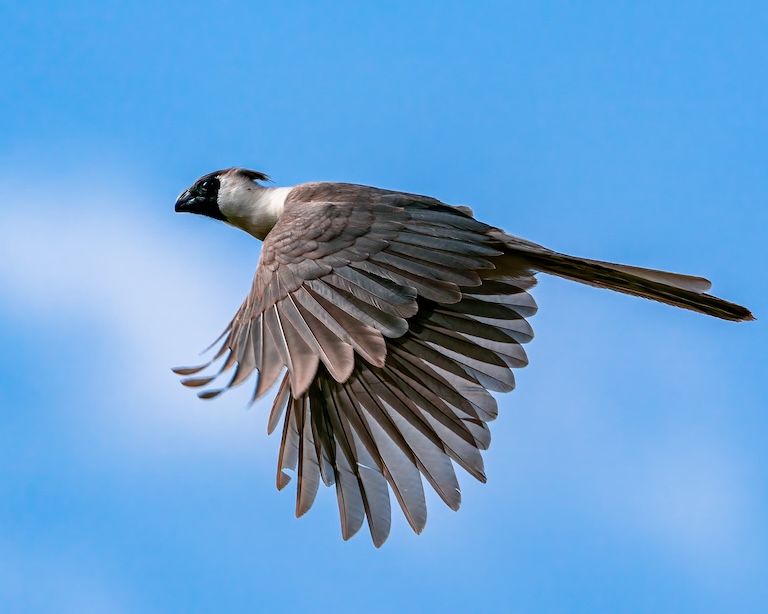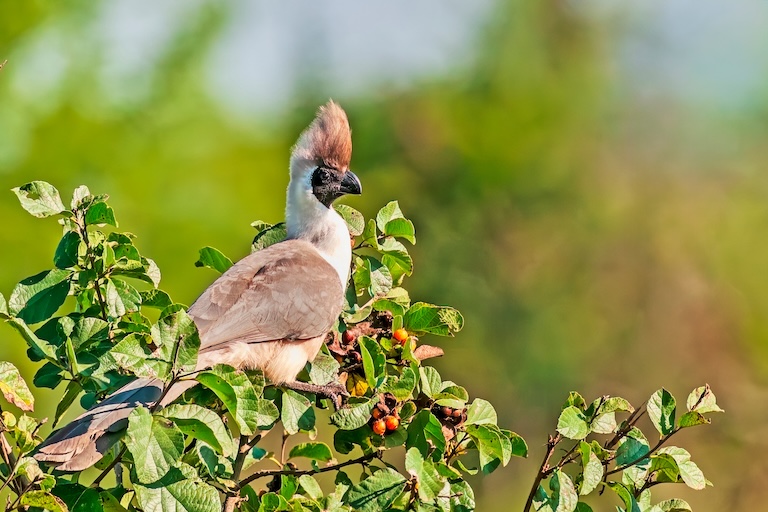Bare-faced Go-away Bird Profile
With the exception of the Dutch, most of us could do with being more direct. Luckily, there are plenty of animals we can take inspiration from.
The Crinifer genus of birds is one that’s widely characterised by a lack of inhibition, from the loud-laughing plantain eaters to the straight-forward go-away birds – and of them all, the bare-faced go-away bird is as bubbly and to-the-point as it gets.

Bare-faced Go-away Bird Facts Overview
| Habitat: | Open woodland, thickets, similar low-density canopy |
| Location: | East Africa, Zambia, Malawi, Ethiopia and DRC |
| Lifespan: | |
| Size: | 48 cm (19 in) long |
| Weight: | Up to 300 g (0.7 lb) |
| Colour: | Mostly grey, with a white neck and black face/beak, a light green breast |
| Diet: | Fruits, leaf buds, and seeds |
| Predators: | Raptors, some primates |
| Top Speed: | Not listed |
| No. of Species: | 1 |
| Conservation Status: | Least Concern |
The bare-faced go-away bird is not as rude as it sounds, it’s just unashamedly loud and social, and given the tropical East African region it’s from, this is pretty standard.
Legend has it this bird chases prey away from hunters and is a bit of a mischief, and this is easy to believe when you hear its call and the bubbling laughter of its relatives.
These may not be as pretty as their turaco cousins but they are as cute, and equally adept at arboreal locomotion, too.
Interesting Bare-faced Go-away Bird Facts
1. They’re monochrome turacos
The Musophages, or banana-eaters are a family of Afrotropical birds best known for being ridiculously pretty.
The turacos come in all the colours you’d typically find in a sweet shop: cherry reds, lime greens, and whatever flavour blue is. Most of them have combinations of these and even more colours, and they hop about in the canopy eating fruits and making prehistoric noises.
The other branch of the macrophages is relatively drably coloured, though they are still a great shape – large birds, with cute little crests and bright eyes.
This side is made up of the plantain eaters and go-away birds, and these often look more or less identical to one another. They’re all part of the same genus of mostly grey, slightly chubby-looing birds, not known for their palette, but at least as well-recognised by their calls.
The name Musophage literally translates to banana-eater, after the banana family, Musaceae. But these birds prefer figs and other round fruits and while the turacos prefer the denser forest canopy, this genus is more commonly found unashamedly out in the open.
This species, as its name suggests, has a characteristic bald face beneath its David Bowie haircut.

2. They’re plantain eaters
A large portion of the genus are referred to as plantain eaters, and once were the sole occupiers of the genus.
This species of go-away bird, like many others, was considered to be in the Corythaixoides genus, but new phylogenetic research has combined the two and the go-away birds and plantain eaters turn out to be the same thing.
This name isn’t entirely accurate, as they rarely, if ever, eat plantains, or even bananas, but as frugivores, it’s not too far off. 1
3. They’re noisy
This whole group of birds have the boisterous nature of a Nigerian matriarch, and this species brings that strong, African energy to the opposite side of the continent with a range that spans most of East Africa and extends up into Ethiopia and down as far as Zambia too.
They are often found alone but are highly mobile and social birds, and will chatter away with one another enthusiastically while jumping about through the branches.
Theirs is likely not the species that gave the go-away birds their name, as their call is a lot less accusatory than some in the genus, but it is still energetic and enthusiastic, and fun to listen to. 2
4. They prank hunters
If 1970s documentaries on African life are to be believed (of course, they’re not), the go-away birds are experts at chasing prey from an approaching human hunter.
The wonderfully-titled South American film Animals are Beautiful People is well worth a watch, as long as it isn’t taken too seriously but it does do a great job of showing why these birds got their name.
Likely stemming from folklore, it’s said that they follow bushmen on hunts, waiting until the last moment to shamelessly chase away their quarry.
The footage, clearly an edited construction of this phenomenon may or may not accurately reflect reality, but it’s likely more accurate than the drunken animals scene in the same movie. 3
5. They’re irregular wanderers
These active birds move around a lot, but unlike migratory species, they’re not very orderly about it. Wherever there’s water and plenty of fruit, they’re happy to just flit about.
This means that it has quite a wide range, but within predictable boundaries: like all go-away birds, it isn’t likely to be found in deserts or any areas that lack fruiting trees. 4
6. They’re agile
Go-away birds and turacos are pretty cool to look at when they’re not moving, but when they start hopping between branches, they take on a whole new look.
Sometimes without so much as twitching their wings, these birds can jump around in trees with tremendous dexterity, running and hopping through the canopy with agility more commonly seen in squirrels.
In doing so, they really give a strong suggestion of what arboreal dinosaurs might have looked like a few tens of millions of years before them.
Bare-faced Go-away Bird Fact-File Summary
Scientific Classification
| Kingdom: | Animalia |
| Phylum: | Chordata |
| Class: | Aves |
| Order: | Musophagiformes |
| Family: | Musophagidae |
| Genus: | Crinifer |
| Species: | personatus |
Fact Sources & References
- Utku Perktaş (2020), “Phylogeography, Species Limits, Phylogeny, and Classification of the Turacos (Aves: Musophagidae) Based on Mitochondrial and Nuclear DNA Sequences”, BioOne Digital Library.
- “Bare-faced Go-away-bird”, xeno canto.
- legendarylakpa (2009), “Go Away bird”, YouTube.
- “Grey Go-Away-Bird”, Animalia.
